The Cat and the Canary, The Ghost Breakers (1939, 1940)
Directed by: Elliott Nugent, George Marshall
Written by: Charles W. Goddard, John Willard, Lynn Starling, Paul Dickey, Walter DeLeon
Starring: Bob Hope, Douglass Montgomery, Gale Sondergaard, Paulette Goddard, Richard Carlson, Willie Best
THE CAT AND THE CANARY / THE GHOST BREAKERS [1939, 1940]
AVAILABLE NOW, from EUREKA ENTERTAINMENT
REVIEWED BY: Dr Lenera
A few days later than intended due to postal holdups, I check out two horror-comedies which paired Bob Hope with Paulette Godard. Hope was once one of the biggest Hollywood stars around, but I’ve not seen a single one of his films until now. These two place him the old dark mystery subgenre which once upon time was one of the most popular around. Do they achieve a good balance of laughs and chills, or do the two elements cancel each other out? Read on.
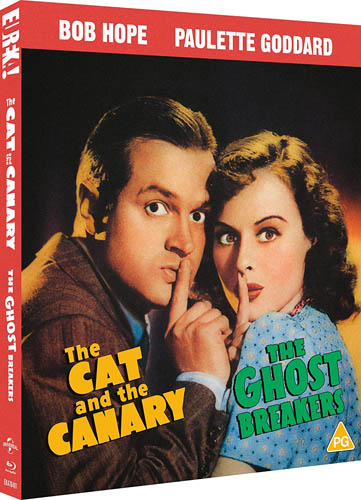
THE CAT AND THE CANARY
RUNNING TIME: 72 mins

Ten years ago millionaire Cyrus Norman passed away in his house way out in the Louisiana bayous. Now on the anniversary of his death, his will is due to be read by his attorney Mr. Crosby, who arrives to find the mysterious Miss Lu living in the place. Six more relatives show up, and the first half of the will is read. Joyce Norman will own the property, but only after 30 days; like previous family members she could go insane, and if she does the name of the heir is written on the second part of the will. This arrangements means that others can increase their chances of inheriting by murdering her or driving her insane. Crosby then informs everyone that they will have to stay overnight, but Lu warns of spirits in the house, while a murderer called “The Cat” has just escaped from the nearby insane asylum…
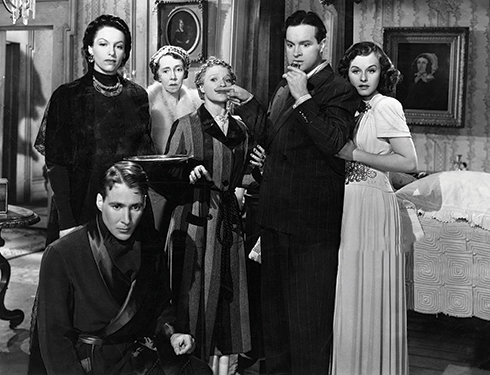
Wills. A gloomy old house. Potential killers. Secret passageways. Mysterious housekeepers. An escaped lunatic. Eyes appearing through holes in a painting. Etc, etc, etc. Even if you know that you’ve never seen The Cat And The Canary, it will probably still seem that you have, because it’s crammed with very familiar elements. In fact said elements would have seemed very familiar even back in 1939 when it came out, because not only was it the third filmed version, and in just twelve years [god they really were remake mad around this time], of John Willard’s play, but the first of these adaptations spawned a popular cycle of very similar affairs. This incarnation is savvy enough and confident enough to have an actor hero who’s performed in many old dark house mysteries on the stage and therefore knows the sort of things that are coming which tend to be of little or no surprise to him; this of course also enables him to work a lot of things out. I haven’t seen the 1927 film of the same title nor 1930’s The Cat Creeps [edited to add that, according to the audio commentary, it’s lost], but it seems to me that this second remake follows the plot but diminishes the role of the heroine a bit to beef up the part of the male hero, who, because he’s now played by Hope, provides a lot of humour. Well, not everyone may call this supposed humour particularly humorous, Hope’s wisecracks inducing as many groans as they do laughs, and he himself is at times annoying, but the semi-meta aspect is interesting, and his jokes don’t get in the way of the suspense much, with most of the major scenes being allowed to play out either without them. However there’s not nearly as much atmosphere as you’d probably expect. Elliott Nugent does generally well with the set pieces, but he’s clearly a comedy director. Indeed this film gives the impression that it was shot quickly and cheaply, as if Universal, for some reason, didn’t think that it would be successful at the box office.
So first on the way to the dilapidated old Norman mansion is Attorney Crosby in Jonathan Harker fashion. “Come back in two hours” says he to his Native American guide, who of course replies “No more rides for me tonight”. Crosby is surprised to find that the house in inhabited. Miss Lu’s first appearance to Crosby, after we’ve seen her creepily looking out of the window, is a doozy, making her seen more sinister; Crosby enters the house to be surprised by the resident black cat, after which he turns back to the door to see Miss Lou, who’s suddenly and silently appeared there, closing it. Miss Lu hardly receives him warmly. “You ought to be glad, it must have been rather lonely here all these years”. “I’m never lonely, I’ve got my friends. .from the other world…they tell me things”. When the lights flicker, she says that “Sometimes they get into the machinery”, though it’s perhaps a disappointment that nothing else is done with this idea which soon gets forgotten. Anyway, Crosby opens the safe containing the two envelopes with the two parts of the will inside, and sees that the letters have been opened, but surely that’s not possible seeing as only he knows the code to the safe? We’re introduced to Hope as Wally Campbell in his canoe, tossing a cigarette into the mouth of an alligator before telling his guide a joke which the guide says he’d heard “Last year on Jack Benny programme”. He’s an actor and the nephew of Mr Norman; also heading for the house are fellow survivors Aunt Susan Tilbury, her companion Cicily Young who’s overjoyed when she sees Wally, Fred Blythe, Charles Wilder and Joyce Norman. Joyce used to go out with Fred and both Fred and Charles are after her, but of course she takes a shine to Wally immediately despite him uttering jokes like, with reference to Norman “They tell me he was so crooked they had to screw him into the ground”. Actually okay, that one’s pretty good, but it’s probably as good as it gets.
As the group gathers in the parlour to read the will, an unseen gong rings seven times. According to Miss Lu, this means that only seven of the eight people present will survive the night. After the reading which nominates Joyce as the heir, to the annoyance of some, and Crosby’s insistence that they all have to spend the night here, a security guard is found prowling around outside, saying that a murderer called “The Cat” who often “Crawls around on all fours, like a cat” has escaped from the nearby insane asylum. And talking of cats, something seriously spooks the actual cat, though the bit involving it that everyone will remember is when it narrowly escapes having a chair leg smashed onto it when someone sees something moving beneath a towel. In the parlour, another character tries to warn Joyce about something, but a hidden doorway opens in the wall and someone pulls him into the space behind it in a nicely done moment. Of course when she tells the others of what she’s seen, they think she’s imagining it and going mad just like the will [or rather the first part of the will] suggested that she might, while Miss Lu’s comment of “The demon in the house has got to him” is hardly helpful. Wally, don’t forget, is used to all this and is of course also keen to get into the good books of his “leading lady” so he decides to accompany her on a hunt for a diamond necklace inside and outside the house. At one point he even says that he doesn’t need a gun with the sort of jokes he cracks, though he may soon surely need one seeing as “The Cat” does seem to be about, lurking around, but what does he have to do with everyone else? Actually it’s all quite well worked out even though there’s only one one real red herring who’s just too obvious, while some changing of clothes seems to happen absurdly fast.
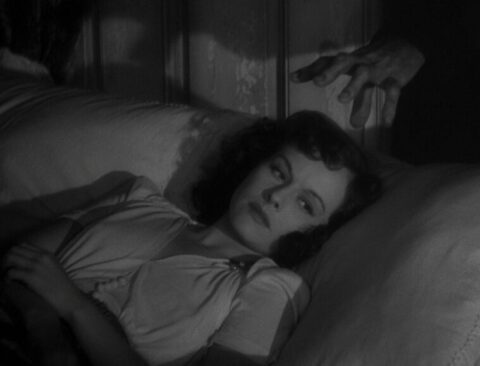
The early bayou scenes have really good back projection – plus unfortunately alligators with their mouths very visibly taped shut. As Norman approaches the house we get a marvelous foggy set with twisted dead trees; later on a shed seems to have a distorted roof and, surrounded by forest, looks right out of a fairy tale. Yet the Norman Mansion on the inside is a disappointment, with the set design curiously uninteresting; this house just isn’t creepy enough except for when we’re in hidden passageways, a cellar and the barn where the cinematography of Charles Lang, which is a slight letdown elsewhere, is able to go to town with great use of darkness, particularly when The Cat’s face is shown so you can just make out some details but not all of them; seeing as not long before this horror films had briefly gone out of fashion and were even banned in the UK for three years, the makers were probably trying to play it safe by not showing any grotesque faces in full, though there’s a rather effective shock of a body suddenly being revealed and falling on to the ground that must have caused some serious screaming back in the day. A genuinely creepy shot of a hand slowly coming out of a wall behind where Joyce is lying is also memorable, and I still have in my mind the last shot of the deranged face of one character [of course I won’t say who] which is lingered on a bit and in close-up too. All in all, while the horror side of things isn’t particularly strong even for the time, it’s generally allowed to play out without intrusive silliness, though the two manage to combine rather well when Wally falls down the cellar steps and remarks that he’s got his hand stuck in something; well one hand in a piece of cheese and the other in a mouse trap.
Wally is actually a coward, though his two female admirers seem to be oblivious to this in one of the more successful and even subtle gags. It sort of makes sense that he’s this way, with his constant wise-cracking maybe being a defense mechanism to compensate for his whimpishness. But were jokes such as “The spirits are back”, “Can you put some in a glass with a little ice?” considered good comedy back in 1939? I say this as a lover of a great deal of old school comedy in an age where comedy seems to be genuinely dying. I even say it even as someone who likes good one-liners. But screenwriters Walter DeLeon and Lynn Starling either don’t seem to be trying very hard here [I assume Hope subsequently got better writers] or I’m having a day when it obviously takes a lot to tickle me. Hope himself looks a little awkward at times, perhaps trying out elements of what would become his basic comedy persona for the first time. I can’t say that this film has made me a fan who wants to go and check out his other work, but you never know, maybe The Ghost Breakers will do that? He does have some chemistry with Paulette Goddard who is nicely vivacious, while out of the rest of the cast probably George Zucco and Gale Sondergaard make the greatest impression. Zucco would go on to play villain after villain though he’s slightly more genial than normal here and it’s both strange and nice; Sondergaard, The Spider Woman herself, plays her role as the sinister retainer to perfection; she would have been just as good in Rebecca one year later as Judith Anderson turned out to be. Ernst Toch’s musical score brings all the required florid melodramatics, including what sounds like an early use of the theramin a few years before Miklos Rozsa employed it.
The Cat And The Canary didn’t wow me quite as much as I thought it might, even considering the familiarity of its ingredients, but parts of it are very well done indeed and, while the horror is more successful than the comedy, the two do balance out quite nicely and don’t intrude on each other.
Rating: 









SPECIAL FEATURES
Audio Commentary with Kevin Lyons and Jonathan Rigby
Bizarrely, that other terrific talk track pairing of Kim Newman and Stephen Jones have done a commentary for this movie – but that’s on the Via Version Australian release. And Lee Gambin did one the on the North American Kino Lorber disc, both 2020. But Eureka usually commission their own tracks and I doubt that anyone would be disappointed by the Lyons / Rigby effort here which could be one of their best. They begin by calling The Cat And The Canary “wonderful”, “marvelous” and “absolutely brilliant” which is stretching things somewhat, though they do go on to do their best to justify such praise. As well as providing lots of genuine enthusiasm, they also give us a lot of detail on the play and what was changed in different versions; here, most of the names were altered and some characters made different, probably to update things because cinema and indeed society had changed so much since 1930, let alone 1927. Violence and outdoor scenes were added. I also learned that most of Zucco’s arm had been shot away in World War 1, that Lang would fart to let everyone know he was ready to shoot, and have some gaffes over a character’s name pointed out.
Kim Newman interview [20 mins]
I watched this immediately after the audio commentary, though it might best be seen after The Ghost Breakers as it also covers that, though not in much detail. As is often the case, Eureka add the ever-busy Newman, who begins by showing his copy of the book Seven Keys To Baldpate by Earl Biggers, which he says started off this whole genre before briefly going through it and saying that this and the follow-up were nostalgic look backs while the idea of placing a funny person in a serious genre, even this one, still endures.
Trailer
THE GHOST BREAKERS [1940]
RUNNING TIME: 84 mins

In New York City, Mary Carter learns that she’s inherited Castillo Maldito on Black Island in Cuba, though is warned that the castle is reputed to be haunted and exists in an environment where voodoo exists. Immediately after, she receives offers from people wanting to buy the property from her. Meanwhile muck-racking radio broadcaster Larry Lawrence mocks, then alerts radio listeners, to the crimes of mobster Fremchy Duvall, and thinks he shoots dead a man because his gun goes off just as this other man is shot by someone else. Larry hides in Mary’s trunk and is unwittingly put on the boat to Cuba. Even on the the ship, there seem to be various parties determined to obtain the castle or what’s in it, and once in Cuba the perils become even more sinister….
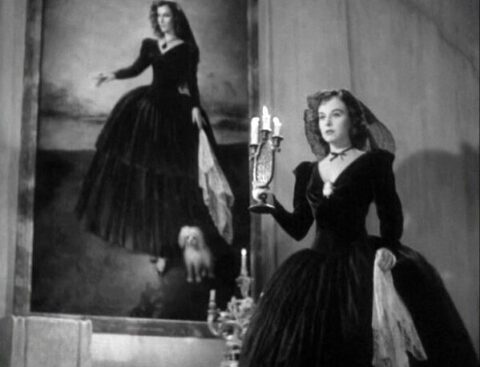
Seeing as I’m doing these reviews in a bit of a hurry, I have no idea which is the better regarded picture; The Cat And The Canary or this, its follow-up with much of the same people involved. However, to my eyes The Ghost Breakers is a somewhat superior effort. Though also based on a play, by The Paul Dickey and Charles N. Goddard, though called The Ghost Breaker without the plural, it seems to make a good attempt to best the earlier film in many ways, be it humour, chills, set design or even Hope, who seems a lot more settled here, and his one-liners, though again by Walter DeLeon but on his own this time, generally being better and delivered more naturally while they’re balanced out by some situational comedy too. Many elements of the earlier film are still present, and even some direct quotes, though the murder mystery aspect is less prominent, with the well constructed [even if it does leave part of the gangster aspect rather hanging] story, which despite throwing in as many aspects as it can fit from gangsters to a flipping zombie consists of just a few long scenes, taking is time to get to its creepy castle, nicely building up the intrigue until we get a tremendous final third full of fun frights and surprises. However, there’s one element which will date and tarnish the proceedings badly for many modern viewers, a servile African-American character who’s very stereotypical, though I tend to approach such things by judging them by what I know to be the standards of the time, and actually there were far more demeaning depictions of African-American folk during the period. There are even positive dimensions to the character of Wally’s valet Alex, even though some readers with a very politically correct mindset may find that surprising. I’ll go into all this more later on in my review.
Castillo Maldito is seen right away, as fog swirls up to form the film’s title. We’re in New York city in the middle of a powerful storm that’s caused a local blackout, an excuse of course for quips like “Basil Rathbone must be throwing a party”. This scares most people, but Mary finds it “exciting” and a “nice night for a murder”, nicely setting up her character. She’s visited by Mr. Parada, a somewhat sinister Cuban solicitor. He delivers her the deed to her inheritance – a plantation and mansion in Cuba. Despite Parada’s attempts to put her off, Mary decides to travel there by ship to inspect the property. Not even a decent sum of money or a phone call from the mysterious Mr. Mederos can convince her to stay put. During much of this, Mary has been listening to Larry Lawrence, who we see giving a hoodlum some money in return for some information. It seems that he has a good thing going on, being allowed by the mob to keep them on the headlines without revealing too much, then revealing their secrets on radio. Larry finishes his latest broadcast, but unfortunately it’s not received well from gang boss Frenchy, who doesn’t take very kindly to being told “how a baby’s innocent hands have softened the hand of a racketeer”, which of course refers to him, then having revealed on air some of the organisations who’d be interested in what he’s been up to. Larry receives a phone call from him, who invites him to his room which is coincidentally on the same floor in the same hotel as Mary, so Larry’s manservant Alex gives him a gun. In the hall, Larry jumps and the gun goes off just as another man is shot. Thinking he’s killed him, Larry takes refuge in Mary’s room and then her trunk, leading to a terrific comic sequence with Alex trying to find said trunk in an ocean of trunks and a drunk man hearing Larry’s voice and thinking Alex is a ventriloquist, plus a rather dirty gag with a finger and a mouth [unless that was just my mind].
On the ship Larry is eventually freed, but Mary receives a death note and narrowly misses a bucket being dropped on her. Of course this just make her more intrigued and determined to get to the castle, and Larry, despite not being a brave chap, decides to accompany her because he fancies her. As is often the case with films of this vintage, the script rushes through the latter aspect – within a couple of minutes of being out of the case he’s putting on music and getting her to dance with him, but then those were the days when a man could put his arm around a woman he hardly knows and it not be considered wrong. I think it’s often worth mentioning such things because for younger viewers of old movies today they can seem odd and not good. Anyway, it’s over half way before any real macabre element is brought in except for talk of voodoo, ghosts, and zombies, and yet we’re having such considerable fun that it doesn’t really matter. Anyway, also on the ship is an old acquaintance of Mary’s, Geoff Montgomery, a young intellectual who regales them with tales of Caribbean superstitions, though one thing that the script disappointingly doesn’t do is have the two compete for Mary’s affections – or maybe it’s not disappointing but a nice surprise? At Cuba, Larry goes off to the island with Alex, though unsurprisingly Mary soon after follows, actually swimming some of the way in waters that, unknown to her until after the fact, contain sharks. In Castillo Maldito, things never get dull for more than a few seconds with chills both non-supernatural and, surprisingly, supernatural too, with a ghost, who likes to get up and walk about – via a rather neat effect of ectoplasm entering his coffin and animated his revived body – before retiring back to his coffin actually being revealed as real, accompanied by organ music that may have also been played by a spook rather than just being part of the music score!
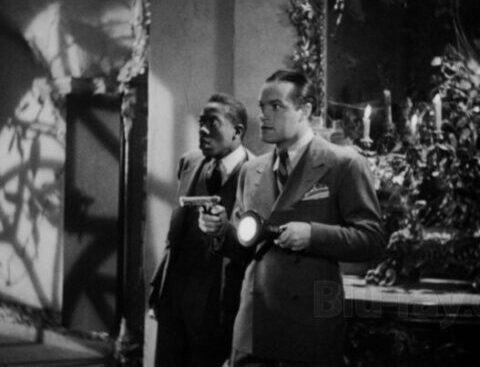
Hope’s one-liners almost disappeared in the concluding portions of the previous film, something that I was thankful for. Here, they keep on coming, but they don’t really detract, seeming better integrated. The cobwebbed, falling apart Castillo Maldito “[How long has it been since anyone’s lived her? 20 years. It’s only been two months since anyone died here”.] still possesses all the atmosphere that you could wish for, the production design of Hans Dreier and Robert Usher being the perfect environment for skullduggery, secrets, ghosts and that zombie. He’s quite menacing, Noble Johnson wearing very effective and convincing makeup which still shows off his features. He’s got rid of rather easily, but is still one of the most memorable zombies of the period. As to whether he’s supposed to be an actual zombie, we aren’t told [in fact we’re not even told why he goes to the castle in the first place] – but if he is, then he’s also a supernatural being in a subgenre where monsters were generally revealed as fake, Scooby Doo-style. Of course humans are the real villains and, truth be told, the worst amongst them isn’t hard to work out, but then as I said before the mystery aspect isn’t as important in this as it was in The Cat And The Canary, with the comedy often better and less samey. Larry’s extreme cramp after being trapped in that suitcase for ages allows Hope to display some physical humour, Larry and Mary’s confusion from reading from a guide map with the pages wrongly displayed is also a neat gag, and the ship’s funnel is also amusingly employed. A joke about Republicans n the previous film is referenced. “A zombie has no will of his own. You see them sometimes walking around blindly with dead eyes, following orders, not knowing what they do, not caring”. “You mean like Democrats”? Oh for such balance in today’s cinema!
Hope is so much better, his jokes flowing from him smoothly rather than being barked out as many of them were before. It’s amazing what difference a year can make. Goddard’s independent, bold heroine may seem like a surprise considering it was 1940, but actually there were more leading female characters of this kind back then than you might think, though of course there were far more African-American characters who were unpleasant caricatures, usually lazy and easily frightened. As Alex, Willie Best is typically required to act slow and have his eyes pop out in amazement or fear, while Hope says things like “You look like a black out in a blackout. Any more of this and I’ll have to paint you white” which I personally wouldn’t have minded if Best had been given some similar lines to throw back at him. However, the script actually has him be of essential help to Larry, in fact he basically solves most of his problems. Perhaps the biggest irritant is that he’s hardly ever addressed by anyone else; in fact everybody seems to pretend that he’s not there. Director George Marshall, another director chiefly of comedy but one who seems well at home with the hijinks at Castillo Maldito, remade this film in 1953 as Scared Stiff as a vehicle for the team of Dean Martin and Jerry Lewis, and there Lewis took Best’s role which was rewritten for a white guy. And look out for Anthony Quinn in two small roles, plus Richard Carlson with a rare early moustache.
The greater amount of back projection isn’t as good and there’s a gaffe towards the end with Don Santiago who seems to have two different resting places, but overall The Ghost Breakers is a cracking piece of entertainment which throws in as much as it can to give the viewer a good time.
Rating: 









SPECIAL FEATURES
Audio Commentary with Kevin Lyons and Jonathan Rigby
As before the Australian and North American Blu-rays had Newman and Jones on the former and Gambin on the latter. Rigby and Lyons provide another great track, with Rigby here able to find old reviews and publicity, including a claim that 35 bats were given auditions by having to fly from bright light to darkness [even though the few bats that we see are obviously fake], plus the name of the actor who played candlelight[ that’s not a mistake from me by the way]. There are more potted biographies here, but also a lot of interesting information such as the really sad fact that Best was credited as “Sleep ‘n Eat” for his early work, and comparisons with the play which began with Wally and Mary meeting. They also love this film though admit certain flaws.
Radio Adaptation [Screen Director’s Playhouse, April 4, 1949] [30 mins]
Hope, along with Marshall who introduces the play, returns to play Wally, though now alongside Shirley Mitchell. There are some changes, such as Frenchie showing up at the castle, plus a nonstop load of new one liners, many of which seem rather topical though some chuckles should still happen.
Trailer
PRODUCT FEATURES
Limited Edition slipcase [2000 copies]
1080p presentation of both films from scans of the original film elements supplied by Universal, with The Ghost Breakers presented from a new 2K master
The Cat And The Canary looks sharp and detailed; The Ghost Breakers, despite being from a newer scan, is slightly softer and has a few short sections where the picture has clearly deteriorated a little, though it’s nothing major. Both films have vivid blacks [though this is perhaps just as well seeing how much black is employed] and even grain balancing. Generally very good indeed.
Optional English SDH
Reversible sleeve featuring original poster artwork
A limited edition collector’s booklet featuring new writing by Craig Ian Mann [2000 copies]
The melding of [mostly] innocuous humour and harmless horror makes this double bill good to view with your kids if you want to get them to watch black and white movies. Great vintage fun. Highly Recommended!


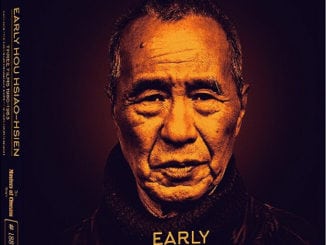


Be the first to comment